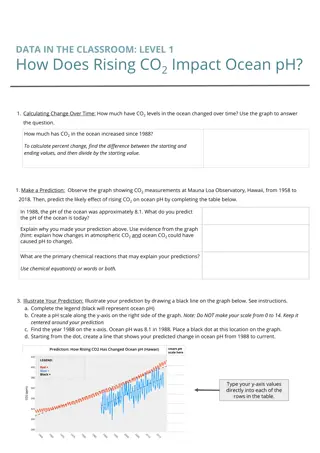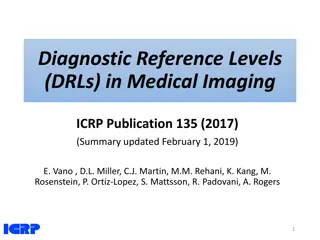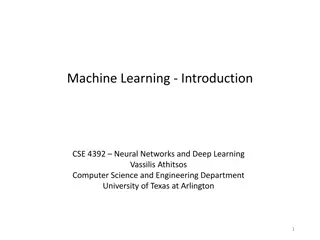Understanding Manufacturing Readiness Levels (MRLs) in Defense Technology
Manufacturing Readiness Levels (MRLs) are a vital tool in assessing the manufacturing maturity and associated risks of technology and products in defense acquisitions. They provide decision-makers with a common understanding of the maturity levels to support informed decisions throughout the acquisi
1 views • 12 slides
Understanding Special Monthly Compensation (SMC) Levels and Benefits
Special Monthly Compensation (SMC) offers various levels of benefits based on the extent of service-related disabilities, such as anatomical losses, blindness, and aid and attendance needs. Veterans may receive different SMC levels like SMC-K, L, M, N, and O depending on the severity and combination
2 views • 42 slides
Enhancing Learning Through Creative Connections Workshop
Achieve higher levels of engagement and deeper learning by utilizing the Creative Connections workshop, designed by Dr. Mike Coffey from Nottingham Trent University. This resource encourages breaking down silo learning, recognizing common skills, and promoting active engagement through structured ac
2 views • 20 slides
Dissolved Oxygen Measurements and Factors Affecting Oxygen Levels
Understanding the importance of dissolved oxygen in water is crucial for the survival of aquatic plants and animals. Factors such as chemical reactions, temperature, pressure, and light penetration influence oxygen levels. The Winkler method is commonly used for dissolved oxygen measurements. This m
4 views • 11 slides
Case Study: Managing High HbA1c and Normal Fasting Glucose Levels
A case study discusses a 69-year-old woman with a history of stable diabetes facing elevated HbA1c levels despite normal fasting glucose. Initial investigations, including a day curve test, reveal high postprandial glucose levels. The analysis leads to identifying iron deficiency anemia, prompting f
9 views • 22 slides
Depth of Knowledge
Explore the concept of academic rigor and the Depth of Knowledge (DOK) levels created by Dr. Norman Webb. DOK levels range from basic recall to extended thinking, emphasizing different cognitive skills and complexity. Rigorous learning involves deep mastery of challenging tasks, fostering critical t
5 views • 27 slides
Understanding Ocean pH Changes Due to Rising CO2 Levels
Explore the impact of rising CO2 levels on ocean pH through data analysis, predictions, and comparisons. Learn how to calculate changes over time, predict pH levels, and understand the processes influencing ocean acidification at different locations. Dive into levels ranging from measuring changes i
1 views • 6 slides
Interactive Math Activity: Melting Cubes Levels 1-5
Engage students with the interactive math activity "Melting Cubes" featuring levels 1-5. Follow the provided guidelines for different grade levels, from K-1 to 4-8, and enhance students' understanding of spatial reasoning and counting. Access the original files for sets 1 and 2 to facilitate a seaml
0 views • 22 slides
Understanding Force Protection and FPCON Levels in the US Military
Force Protection (FP) involves preventive measures in the US military to mitigate hostile actions. FPCON is a system to respond to terrorist threats against military facilities by determining security levels. FPCON levels vary from Normal to Delta based on the assessed threat level. The purpose of F
1 views • 13 slides
Managing Blood Sugar Levels at Home for Low/No Vision
Explore the importance of monitoring blood glucose levels at home for individuals with low/no vision, learn about talking blood glucose meters, and make continuous glucose monitors accessible. Understand why maintaining blood sugar levels is crucial to prevent complications in diabetes, and get tips
2 views • 25 slides
Understanding Learning Intentions and Success Criteria
Learning intentions and success criteria play a crucial role in enhancing student focus, motivation, and responsibility for their learning. Research indicates that students benefit greatly from having clear learning objectives and criteria for success. Effective learning intentions should identify w
1 views • 24 slides
Hosting a Staff Briefing About T Levels
This slide deck, designed by the DfE T Levels Team, is a resource for schools/colleges conducting a staff briefing on T Levels. It aims to generate interest and positivity among staff about T Levels, providing a customizable presentation that can be delivered in 20-30 minutes. The deck includes note
1 views • 29 slides
Experiential Learning Portfolio Program at Barry University
Experiential Learning Portfolio Program at Barry University's School of Professional and Career Education (PACE) offers a unique opportunity to earn college credit for learning gained from work and community service experiences. Through this program, students can showcase their experiential learning
0 views • 16 slides
Understanding T Levels: The New Pathway to Skills and Opportunities
T Levels are a vital two-year qualification designed for 16 to 19-year-olds, bridging the skills gap for employers and empowering students with practical skills and workplace readiness. With a mix of classroom learning and industry placements, T Levels offer a technical alternative to traditional po
0 views • 8 slides
Diagnostic Reference Levels in Medical Imaging and Radiation Protection
The concept of Diagnostic Reference Levels (DRLs) is crucial in evaluating the amount of ionizing radiation used in medical imaging procedures. DRLs help determine if radiation levels are appropriate and need optimization. Authorized bodies establish numerical DRL values as advisory guidelines. Loca
1 views • 26 slides
Levels of Reflectiveness in Learning and Writing
Explore the levels of reflectiveness in learning and writing, starting from habitual actions to profound reflections. Understand the progression from providing material without meaning to critical analysis and personal interpretation. Discover the importance of relating concepts to experience and ch
0 views • 7 slides
Understanding T Levels in Higher Education
T Levels are a new type of two-year technical education courses designed for 16-19 year-olds, focusing on a blend of classroom learning and industry experience to prepare students for skilled employment or further study. Developed in collaboration with employers, T Levels offer a more rigorous and s
1 views • 14 slides
Understanding Low Testosterone Levels and Treatment Options for Men
Testosterone is a vital steroid hormone that plays a key role in the development of male characteristics. Low testosterone levels can lead to various health effects, including decreased muscle mass, bone density, and libido. Testosterone replacement therapy (TRT) is commonly used to treat males with
0 views • 36 slides
Seminar on Machine Learning with IoT Explained
Explore the intersection of Machine Learning and Internet of Things (IoT) in this informative seminar. Discover the principles, advantages, and applications of Machine Learning algorithms in the context of IoT technology. Learn about the evolution of Machine Learning, the concept of Internet of Thin
0 views • 21 slides
Innovative Learning Management System - LAMS at Belgrade Metropolitan University
Belgrade Metropolitan University (BMU) utilizes the Learning Activity Management System (LAMS) to enhance the learning process by integrating learning objects with various activities. This system allows for complex learning processes, mixing learning objects with LAMS activities effectively. The pro
4 views • 16 slides
Understanding AYP in Education: Goals, Subgroups, and Performance Levels
AYP (Adequate Yearly Progress) is a measurement used in education to assess schools' performance in meeting academic standards. AYP is calculated at both building and district levels based on various subgroups such as race, income level, and English proficiency. This assessment includes recently arr
0 views • 57 slides
Guidelines on EPA Region 9 Response Action Levels for TCE Contamination
EPA Region 9 has established response action levels for TCE contamination, with tiered concentrations for different exposure scenarios. The State of California provides guidance aligned with these levels. DTSC concurs with EPA's residential and industrial response levels but recommends consultation
0 views • 10 slides
Unlocking the Power of Online Learning with Jenifer Grady
Explore the transformative nature of learning through online platforms with insights from Jenifer Grady. Understand the essence of learning, reasons behind learning, accessibility, and the concept of online learning. Discover how learning can be achieved anywhere, anytime, and delve into the world o
0 views • 26 slides
Understanding Glycaemic Index in Nutrition and Health
Glycaemic Index (GI) measures how carbohydrate-containing foods affect blood glucose levels. High GI foods raise blood glucose rapidly, while low GI foods release glucose gradually. Studies track impacts on blood glucose levels, insulin secretion, fat storage, and pancreatic function. High GI foods
0 views • 15 slides
Guide to Structured Integrated Masters Degrees
Understand the structured progression through levels, credit blocks, and learning hours in integrated masters degrees. Learn about the typical structures at different levels and how to navigate your curriculum effectively. Get insights into Foundation, Certificate, Intermediate, Honours, and Masters
0 views • 8 slides
Understanding Blooms Taxonomy in Educational Settings
In the classroom, understanding Bloom's Taxonomy is essential for effective teaching and learning. This taxonomy, created by Benjamin Bloom, categorizes levels of thinking skills from basic memorization to higher-order critical thinking. The revised Bloom's Taxonomy emphasizes the importance of prog
0 views • 24 slides
Understanding S-100 Readiness Levels for Product Development
The concept of S-100 Readiness Levels, based on NASA's Technical Readiness Levels, is crucial for progressing ideas from research to regular product use. This framework, introduced by the International Hydrographic Organization, ensures a clear understanding of a specification's readiness for operat
0 views • 9 slides
Understanding Bloom's Taxonomy: A Guide to Cognitive Levels
Blooms Taxonomy, developed by Benjamin Bloom, categorizes thinking into six cognitive levels, from remembering to creating. The original taxonomy includes knowledge, comprehension, and application as lower levels, and analysis, synthesis, and evaluation as higher levels. In the revised version, the
0 views • 10 slides
Understanding Serum Iron Levels and Implications
Iron is essential for healthy red blood cell production, with serum iron tests measuring iron levels in the blood. Abnormal levels can indicate conditions like iron deficiency or iron overload, leading to symptoms such as fatigue, weakness, and more serious complications. Knowing normal ranges and i
0 views • 8 slides
Overview of Georgia Milestones Assessment for 4th Grade Students
This content provides an insightful overview of the Georgia Milestones assessment for 4th-grade students. It covers the assessment format, content areas such as Reading/ELA and Math, achievement levels, and descriptors to gauge academic proficiency levels. The information includes details on what Ge
0 views • 14 slides
Understanding Online Learning in Machine Learning
Explore the world of online learning in machine learning through topics like supervised learning, unsupervised learning, and more. Dive into concepts such as active learning, reinforcement learning, and the challenges of changing data distributions over time.
0 views • 49 slides
Impact of Online Learning on Parental Engagement in CLD Context
The global pandemic in 2020 led to the closure of schools, shifting learning to online platforms. This study explores how online learning has affected parental engagement in Culturally and Linguistically Diverse (CLD) contexts. Family Learning, distinct from homeschooling, plays a crucial role in en
0 views • 11 slides
Understanding Methanol Metabolism and Blood Levels
This content discusses the difference between background/endogenous and exogenous methanol, how metabolism of endogenous methanol affects exogenous metabolism, and the impact of exposure to different levels of methanol on blood concentrations. It highlights EPA PBPK models and assumptions regarding
0 views • 16 slides
Understanding Isolation Levels in Database Management Systems
Isolation levels in database management systems provide a way to balance performance and correctness by offering various levels of data isolation. These levels determine the degree to which transactions can interact with each other, addressing conflicts such as dirty reads, non-repeatable reads, and
0 views • 18 slides
Exploring Levels of Analysis in Reinforcement Learning and Decision-Making
This content delves into various levels of analysis related to computational and algorithmic problem-solving in the context of Reinforcement Learning (RL) in the brain. It discusses how RL preferences for actions leading to favorable outcomes are resolved using Markov Decision Processes (MDPs) and m
0 views • 18 slides
Understanding Machine Learning: Types and Examples
Machine learning, as defined by Tom M. Mitchell, involves computers learning and improving from experience with respect to specific tasks and performance measures. There are various types of machine learning, including supervised learning, unsupervised learning, and reinforcement learning. Supervise
0 views • 40 slides
Analysis of 2016 Standardized Matriculation Exam Results in Foreign Languages
Analysing the 2016 standardized matriculation exam results in English and French, this study evaluates the appropriateness of CEFR target levels, investigates score distributions, explores differences based on gender and school types, and examines the impact of years of learning on French proficienc
0 views • 5 slides
S-98 Interoperability Scopes Overview
This paper discusses options for defining interoperability scopes, restructuring the draft S-98 interoperability specification, and assessing the implications of implementing different levels of interoperability. It suggests a phased introduction with pauses for evaluation, focusing on lower complex
0 views • 8 slides
Lifelong and Continual Learning in Machine Learning
Classic machine learning has limitations such as isolated single-task learning and closed-world assumptions. Lifelong machine learning aims to overcome these limitations by enabling models to continuously learn and adapt to new data. This is crucial for dynamic environments like chatbots and self-dr
0 views • 32 slides
Enhancing Learning Through Co-Created Interactive Courseware and Learning Analytics
Explore the innovative concept of co-creation in interactive courseware and learning analytics to improve student learning outcomes. Discover how students collaborate in a social learning environment, track their progress, and engage in dialogic and constructive pedagogical strategies. Harness the p
0 views • 19 slides







































